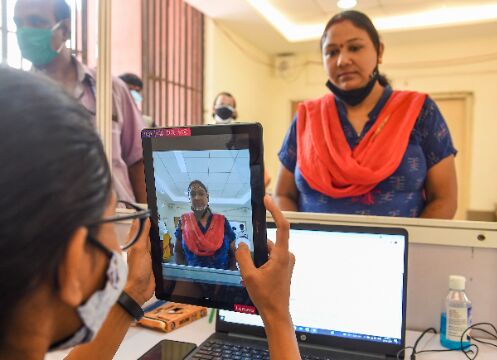In fine fettle
Notwithstanding the politicisation of vaccination drive by the opposition, the Central Government stood firm on its resolve to vaccinate the last Indian free of cost

On International Yoga Day, India entered a crucial phase in its vaccination drive. The country set a world record of administering more than 80 lakh vaccines a day, silencing critics and beating vaccine hesitancy. As the Centre undertook the task of procuring vaccines for the states and decided to provide them free of cost to everyone above the age of 18 years, we look back at the highs and lows of the entire drive to date.
Early breakthrough
On January 16, 2021, India began the world's largest vaccination drive. It was among the very few countries that had their own vaccines. Given the history of vaccine development in the country, this event was an exception than a norm. India had been decades behind in developing vaccines for diseases such as Measles, Hepatitis-B, Pneumococcal and so on as compared to developed nations. But this time, from developing the vaccine to rolling it out across the length and breadth of the country within a gap of nine months, India fast-tracked its vaccination programme.
Back in April 2020, when the world was coming to terms with the advent of an invisible enemy, the Modi government put its weight behind India's pharma industry. A Vaccine Task Force was constituted to clear the path of vaccine makers by removing bureaucratic hurdles. Monthly reviews, with the Prime Minister streamlining communication channels, ensured adequate funding and motivated the entire state machinery to focus their collective energies on an early breakthrough.
As early as June 30, 2020, deliberations with the PM started on a layout of a plan of action for the distribution of the vaccines. PM Modi laid out four guiding principles for India's vaccination drive. These were:
1. Identifying vulnerable groups and prioritizing them for early vaccination
2. Vaccination for anyone, anywhere
3. No one should be left behind
4. Use of technology to monitor and support the vaccination drive
In April 2020, we had 30 vaccine candidates. Out of these 30, the Serum Institute of India's Covishield and Bharat Biotech's Covaxin received approval for emergency use by the Drugs Controller General of India in January 2021. It was no small feat. India having its own vaccines meant that it would not only save the lives of Indians but would also emerge as a beacon of hope for other nations.
Phase-wise distribution
Considering the size and scale of the target, it was rightfully decided to carry out the drive in a phased manner. In the first phase, three crore healthcare and frontline workers were given the jab. These early strides helped us secure the lives of frontline workers who have been at the forefront of the fight against COVID-19. It was followed by the opening up of vaccination for the other most vulnerable population — people aged 60 and above and those above 45 years of age with comorbidities. Notably, the vaccines that the Centre was providing to states were free of cost.
Vaccine politics
Even as India was carrying out the drive in a smooth fashion, a band of political naysayers and opportunists jumped in, asking the Centre to decentralise the vaccination programme. West Bengal Chief Minister shot a letter asking the Centre to allow states to procure vaccines directly. Odisha CM asked for vaccines to be made available in the open market. DMK President, MK Stalin, also wrote a letter to PM Modi and demanded that restrictions on states for direct procurement be lifted. Congress leader Rahul Gandhi also demanded the vaccine programme be decentralised with states having a greater say. Not to be left behind is the Contrarian-in-Chief Arvind Kejriwal who made the case for decentralisation as well.
Considering these demands and adhering to the principle of cooperative federalism, the Centre allowed states to procure vaccines directly and also opened the vaccination drive for everyone above the age of 18 years in May 2021. To ensure that the poor and vulnerable are covered under the programme, the Centre continued to provide vaccines to the state free of cost.
Opposition's inefficiency
On May 1, a pandora's box was opened and the incompetence of the opposition-led state governments began to unravel. Delhi CM Arvind Kejriwal, who claimed to vaccinate the entire Delhi in three months, could not place a single order for vaccines. Reports of wide-scale wastage of vaccine doses from Rajasthan, Chhattisgarh, Jharkhand became a daily affair. A vaccine scam broke out in Punjab. The state government was charged for selling vaccines to private hospitals, which was selling them to people at an inflated price.
Back on track
Amid the heavy politicisation of the national effort, creating a total mess of the otherwise smooth-running vaccination drive, it was the common masses who suffered the most. Unwilling to sit and be a mere spectator of the chaos created by the states, PM Modi once again rose to the occasion and readied the Centre for the task of vaccinating all for free.
Politics notwithstanding, India is proving out to be unstoppable in beating the invisible enemy. Having administered more than 31 crore doses already, India's inoculation drive is not only the world's largest but also the fastest. As a nation, in the last seven years, we have overcome tremendous challenges with a collective spirit. Once again, we need to invoke the spirit of Jan Bhagidari to overcome vaccine hesitancy and achieve the target of full vaccination by the year-end.
The writer is an MLA and Former President of BJP Delhi. Views expressed are personal



